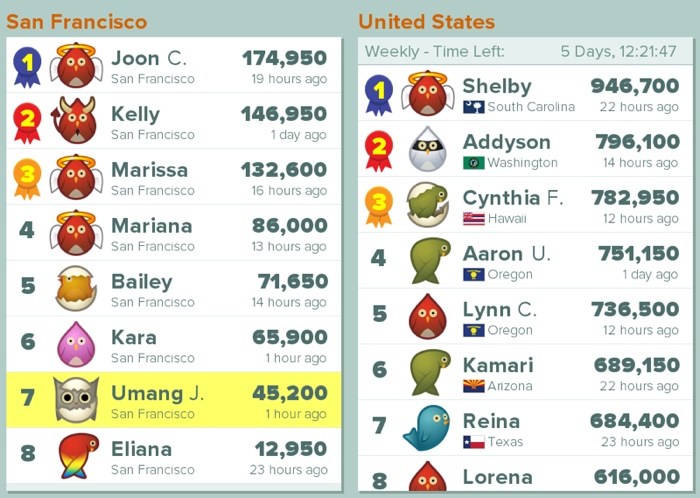Leaderboards in games and classrooms
Leaderboards are found in all games — they are expected to drive competition, inspire players to strive harder to win, and play more. Many social apps have started using them too. For example, Foursquare has a feature where you can become the “mayor” of a restaurant based on the frequency of your checkins there.
However, leaderboards also often have a negative fallout over a longer period of time. Two articles that mention this: (1) The Psychology of High Scores, and (2) Three Common Gamification Mistakes.
Over time, leaderboards detract from having fun or making actual progress. They change the game to becoming about climbing the leaderboard. They also result in users stuck at the bottom of the leaderboard feel terrible. Sometimes the highest scores on a leaderboard are so much larger than a user’s current scores that it feels impossible to achieve and causes them to give up early. For example, check out the scores in the two screenshots below, from a game I’ve been recently playing.

A leaderboard from the game Burds
Smarter games have tried to work around this problem by splitting up the leaderboard into multiple. Some “local” leaderboards amongst only your friends or in your city that better suits newer or casual players, and a global leaderboard for more competitive hard-core players. Or they periodically reset leaderboards to zero.
Our schools and classrooms have leaderboards too with a similar fallout that we are not fixing.
The leaderboard is how well the students are doing relative to each other. Every term or year, there are aggregate marks or grades given and ranks assigned. Performance in non-academic fiels are also graded comparatively. Even if there is no formal ladder, students exchange this information and internalize it.
The leaderboard can be implicit. And reaction to a leaderboard is similar to that in those games. The best students (the top 3? top 10?) compete to better each other. Everyone else either accepts their place on the ladder or feels terrible about it (and about themselves). This is repeated in multiple places – academics, sports, other activities. The vast majority of students are nowhere near the top of any leaderboard and the system just doesn’t work for them.
Unfortunately, the price of quitting the game is too high. And these leaderboards cannot be reset. Starting a new year is not a reset – everyone doesn’t simply return to the same baseline. If a student has not performed well, they already lack the skills and, more importantly, the confidence to perform well this time. If anything, the baseline gap between individual students increases.
It is like making the games tougher each round, and expecting a player who could not win the previous round to miraculously win this level. Online games have made leaderboards less front and center now. They use mechanics like quests and maps to guide the user through a deterministic path of progression. Classrooms ought to learn from games (yes, the irony is not lost here), and shift the focus to shared fun and personal progress.